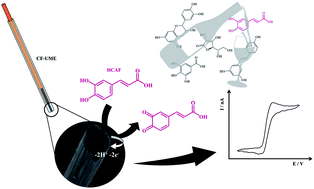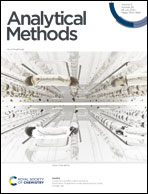A carbon fiber ultramicroelectrode as a simple tool to direct antioxidant estimation based on caffeic acid oxidation†
Abstract
This work describes the construction and evaluation of carbon fiber ultramicroelectrodes (CF-UMEs) in the voltammetric estimation of the antioxidant capacity of wine and grape samples based on caffeic acid (HCAF) oxidation. For this, lab-made CF-UMEs were constructed using an arrangement of six carbon fibers (7 μm diameters individual) assembled in a glass capillary, and caffeic acid (HCAF) was used as a standard solution. By using the most straightforward 2-electrode cell arrangement (the CF-UME as a working electrode and Ag/AgCl as a reference/auxiliary electrode), voltammetric measurements of a 1.0 mmol L−1 HCAF solution were done in the absence of a supporting electrolyte. A sigmoidal voltammetric profile was observed in CF-UMEs caused by a more effective mass transport by radial diffusion, which leads to a rapid formation of the diffusion layer. Reproducibility studies for different 6-fiber electrodes manually constructed in different batches showed an RSD of less than 5%. For the same electrode surface, a variation of 2.7% was observed. Under optimized conditions, a linear relationship between anodic peak current and HCAF concentration from 3.0 to 500 μmol L−1 with a sensitivity of 12 μA L mol−1 was reached. The limits of detection (LOD) and quantification (LOQ) were calculated to be 0.41 and 1.26 μmol L−1, respectively. The proposed electrochemical method was applied in the estimation of the antioxidant capacity in three different wine samples as well as in green and red grapes. Concordant and satisfactory results by comparison with a proper method were obtained, which suggests that the proposed sensor can be successfully applied for direct analysis of wine and grape samples by estimation of HCAF content.



 Please wait while we load your content...
Please wait while we load your content...